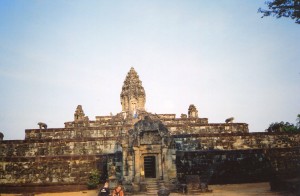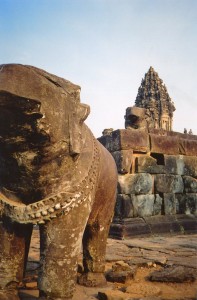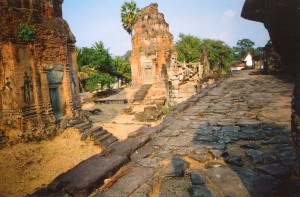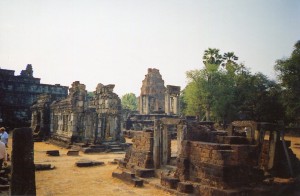Now that Khmers had created the foundation of their empire around Angkor, they began to build big. In the late ninth century, they created architectural traditions that lasted throughout Angkor’s history.
King Indravarman spearheaded a construction program that became the main prototype for all later kings. Jayavarman II had laid the political and spiritual foundations for the Khmer empire (see What Wat? How Was Angkor Wat Created?, but Indravarman built things that we can still gawk at today. He created much of the Khmer empire’s wow factor.
In this post, we’ll explore one of the first great Khmer buildings, the Bakong. It’s a key predecessor of Angkor Wat.
1. Indravarman built the Bakong with sandstone in 881. He probably constructed it over an earlier temple.
2. The Bakong was the center of the royal cult. It represented the cosmic mountain, as Angkor Wat’s center later did.
3. The Bakong is five nearly square levels of sandstone on top of each other. They represent different levels of existence. The realm of nagas (magical snakes that live in underwater kingdoms) is the lowest, and the world of the maharajas (great kings) is the highest. So an ascent to the top represents a spiritual journey (the tower at the top, in Angkor Wat’s pineapple style was built in the 12th century). This idea was made more elaborate at later great monuments like Angkor Wat and the Bayon.
4. The Bakong is very symmetrical. A stairway ascends each side, and sturdy elephants guard the corners. Khmers loved symmetry. They already had emphasized it at the old Chenla capital Ishanapura. They would make it stunningly more complex at Angkor Wat and the Bayon.
5. 8 brick shrines were built around the monument. Each housed a different murti (body) of Shiva. The 5 brick temples around the center are probably the survivors.
6. Several other buildings were constructed around the temple. Some might have housed ritual objects, others could have been priests’ quarters. Some might sheltered pilgrims to the royal center.
These buildings were free-standing. Angkor Wat integrated all structures into one complex system of courtyards. But the Bakong’s buildings were still laid out on a symmetrical plan.
The entire area around the Bakong was thus formal. People approached Indravarman’s royal cult center with respect. This wasn’t a place for playing air-guitar.
The Khmers knew how to impress from the get-go. The Bakong is big, but it’s finely proportioned. It embodies strength and confidence. The Khmers would build on its aesthetic foundations for the next 500 years.
But Indravarman wasn’t done. We’ll explore equally magnificent works in the next post.





Comments on this entry are closed.